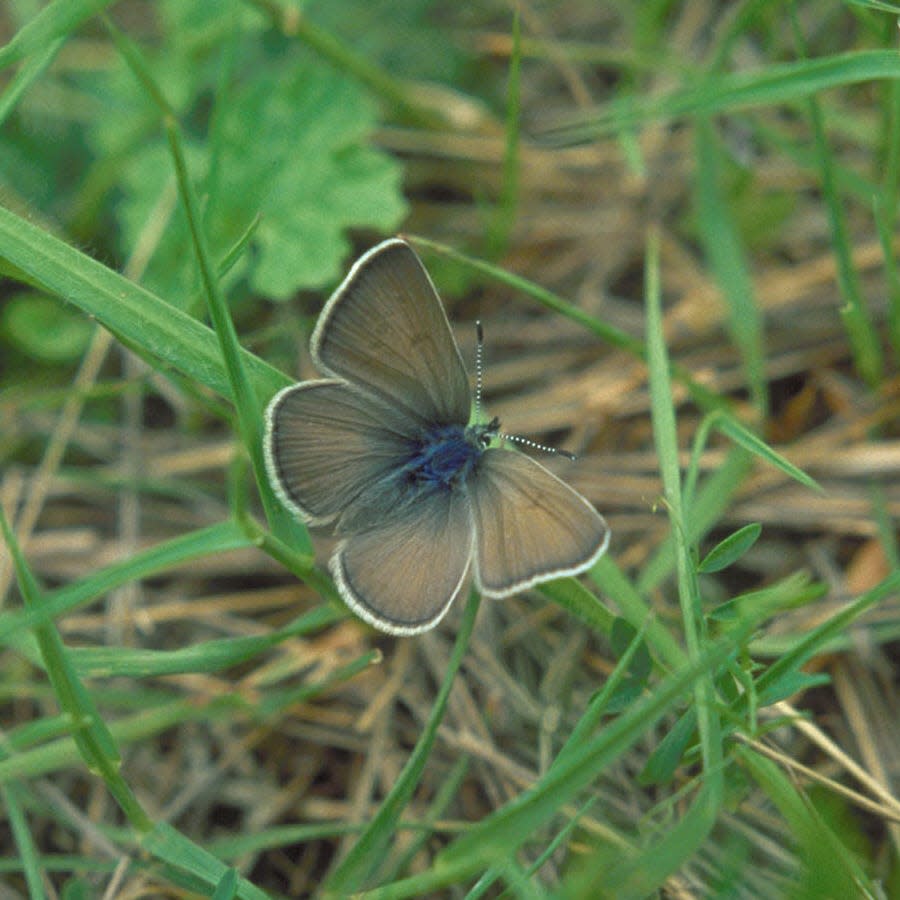Efforts continue to save habitat of butterfly unique to Willamette Valley
Fender's blue butterflies are only found in the Willamette Valley, living in prairie meadows among the Kinkaid's lupine.
But their numbers have shrunk as their habitat has disappeared. Environmentalists and federal officials are trying to change that.
One of the largest known populations of the butterfly exists in the Baskett Slough National Wildlife Refuge, in Polk County west of Salem. In 2020, the Trust for Public Land secured 183 acres adjacent to the refuge to protect the habitat for the butterfly.
Now, a secluded area of woods and prairie southeast of Brownsville is being targeted for a habitat restoration project by the Bureau of Land Management, which could include cutting down conifers in a commercial timber sale to protect its Fender's blue butterfly population.
From now until July 13, BLM is seeking the public’s input on the tentative project.
The 224-acre area, known as the Oak Basin Prairies, was first designated as an Area of Critical Environmental Concern in 2006, a year after the butterfly was discovered in the area.
The Oak Basin Prairies is one of three known habitats for the butterflies east of Interstate 5, with 13 known locations total in the Willamette Valley.
The Oak Basin Prairies' population of the butterfly has dropped as low as 12 in 2017, but has since risen to between 30 and 40, according to the BLM.
Read more: Fender's blue butterfly habitat gets federal boost
The BLM land considered for restoration in Brownsville is in a hilly area south of Courtney Creek Country Road, and is bordered to the west by two private properties owned by tree farmers.
Over the years, conifer trees have encroached on the prairie meadows — reducing them by at least 20% since 1875. BLM now is stepping in with the goal of protecting both the butterflies and its host plant, Kincaid’s lupine, which is federally threatened.
Cutting down the trees would in turn expand meadows for butterflies and reduce competition for oak trees.
The area of environmental concern consists of 180 acres of forest and 44 acres of meadow, but at this point, BLM is unsure what percentage of those trees could be removed in the project in the timber sale.
“There's been a lot of effort going into gathering data in these parcels to see what is really, truly appropriate for sustained timber yields in the long term,” BLM botanist Jessica Celis said. “We're working to get those details sorted out soon, but we don't have them quite yet.”

Other steps taken to protect the plants and butterflies could include cutting down non-native and invasive plants, or planting native nectar and host plants to improve the habitat for Fender's blue butterfly.
A unique aspect of the project is that some areas targeted for restoration are designated as “harvest land base,” meaning BLM uses it for timber production, while in other sections tree-cutting can only be for environmental protection purposes.
In some sections, those designations overlap, and Celis said BLM is trying to balance the two goals of restoring and enhancing the natural aspects, while also sustaining its timber yield.
At a community meeting, one of the nearby property owners, tree farmer Jim Merzenich, said he has been in support of BLM’s restoration efforts and that he has worked with them since the first Fender’s blue butterfly was found on his property in 2005.
Merzenich, who owns Oak Basin Tree Farm, said he intends to do some prescribed burning to help restore butterfly habitat, and that in the past he has gotten grants from BLM for smaller projects such as creating tree-less corridors allowing butterflies to expand into more areas.
“We’re very environmentally sensitive to what we’re doing. Right now what we’re going to be doing is thinning,” Merzenich told The Register-Guard. “We’ll have to continue to control the noxious weeds that tend to compete with the lupine.”
BLM biologist Grace Hopkins said the area does not overlap with known habitat for the northern spotted owl or any other threatened species.
“Our main concern is the butterfly for this site and trying to expand the meadow habitat and make things better for that species,” Hopkins said.
Louis Krauss covers breaking news for The Register-Guard. Contact him at lkrauss@registerguard.com, and follow him on Twitter @LouisKraussNews.
This article originally appeared on Register-Guard: BLM seeks input on tree-cutting to protect Fender's blue endangered butterfly

